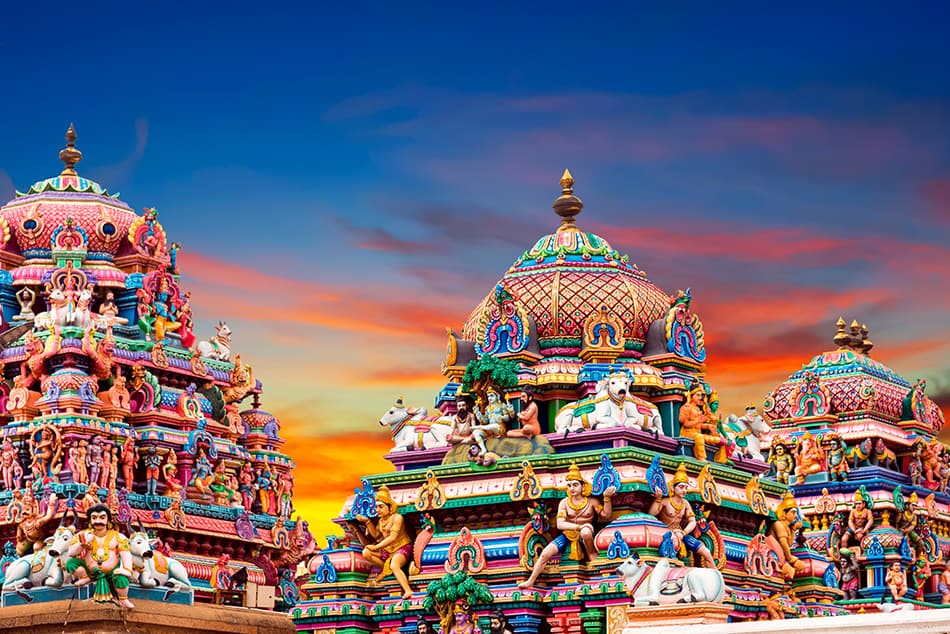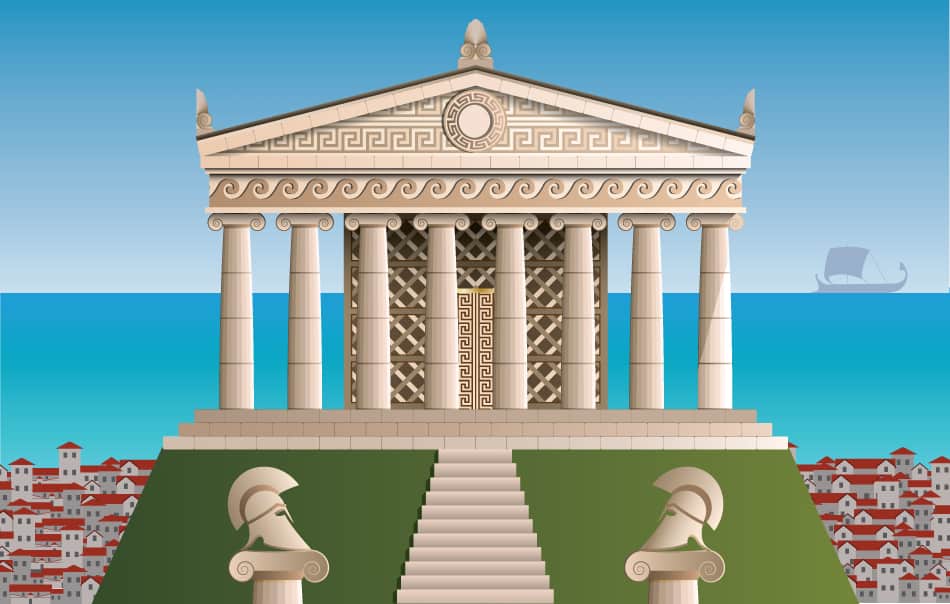Temples are among the earliest structures known or erected by men. The word temple comes from the Latin word ‘templum,’ which means a sacred space. The etymology of the word can give anyone an idea of what a temple is, and that is for religious or spiritual activities, including praying and making sacrifices.
Religions like Hinduism, Jainism, and Buddhism are known to call their buildings or structures for religious and spiritual activities as temples. Other older faiths or religions like those of the ancient Egyptians held spiritual gatherings or activities in temples.
In this article, you will know more about the parts of some types of temples.
In This Article
Hindu Temples

Hindu temples serve as a place for big events, and occasions as most Hindus use family altars for their daily prayers and worship. For Hindus, temples are artificial temples where a chosen deity’s image is enshrined.
Hindu temples are also not a place where the worshippers congregate to listen to sermons. It is more of a structure where Hindus can socialize with each other. In the old days, only royalties, noblemen, and priests were allowed inside Hindu temples. Even today, most Hindu temples are restricted to non-Hindus.
In India, the basic form of a temple is a square cell that’s oriented to four cardinal directions. At the center of the square cell is a platform with an image of the deity. Then there’s a flat roof overhead and a doorway on the east. In front of this doorway is a porch or a platform that’s usually shaded by a roof and supported by pillars. It is in this porch or platform where the worshippers gather before and after they approach the deity.
More complex temples, meanwhile, have galleries and hallways. These parts are commonly set on platforms with stairways connecting to different levels. Some large temples even have separate buildings for other purposes like meditation.
In southern India, temples have large gates. These structures also often have barrel-vaulted roofs surmounting the inner chamber and temple hall. One example of a temple with these parts is the Khmer temple of Angkor Wat located in Cambodia. In north India, most temples have curved towers.
Greek Temples

可以說,寺廟是最recognizable structure in all of Greece. The Parthenon, undoubtedly the most popular Greek tourist spot, is a temple dedicated to the goddess Athena. Other popular temples of the ancient Greek civilizations are the Erechtheion, the Temple of Zeus, and the Temple of Hera.
The Greeks called their temples naos, which means dwelling. The earliest temples were made from materials like wood and mud brick, which, as you may realize, don’t survive long.
The Greek temples are believed to have emerged as early as 10 B.C. Just like the temples in India, the temples in Greece have their basic forms. It’s usually a simple rectangular room with walls creating a shallow porch. The room is also the central part of the temple. It’s called cella or naos. It has no windows. It is also where the cult statue is often placed.
The front porch of the temple is called the pronaos. It also includes the extended walls called antae. There’s a door that connects the naos to the pronaos. At the back of the naos is another room, called the opisthodomos. It serves no real purpose aside from showing the balance to the pronoas. But there is no door connecting the naos to the opisthodomos. At the far end of the naos is the adyton, a restricted space that also serves as a backup area of the opisthodomos. Meanwhile, the platform upon which the columns of the Greek temple rest is called the stylobate. Colonnade is the series of columns upon which the entablature sits.
You have likely heard of the word entablature before. The word translates to ‘table.’ It is the upper portion of the temple that looks like a table on top of the legs of the columns. It is supported by three layers. The bottom layer is called the architrave, the middle layer is called the frieze, while the topmost layer is called the cornice. The entablature is one of the three vertical parts or components of a Greek temple; the two others are the floor and columns.
Speaking of columns, Greek temples are generally categorized according to the ground plan and the arrangement of the columns. A temple with columns only at the front is called a prostyle temple, while an amphiprostyle temple has columns at both the rear and the front. There are also temples with a single line of columns around the exterior, and these are called peripteral temples. On the other hand, dipteral temples are those with a double row of columns around the exterior.
Going back to entablatures, the Greeks put elaborate finishes on it to make their temples look more impressive. The entablature of Greek temples had elaborate antefixes or vertical blocks that conceal covering tiles of a roof. Greek temple entablatures also had elaborate revetments and colorful terracotta that made that part of the temple look more grandiose.
Roman Temples

For the Romans, the temples served as a place to worship their gods. It can be said that Roman temples are one of the key features of Roman civilization. Roman temples were usually dedicated to a god, a goddess, an Emperor, or a member of the royal family.
羅馬寺廟被Etru受寺廟scans, an indigenous Italian race that peaked in the 7th century B.C. However, the Etruscans also adopted other architectural styles into their temples, such as those of the Greeks. It can therefore be said that Roman temples were partly influenced by Greek temples. The style of columns is arguably the single most noticeable similarity between Greek and Roman temples. Roman temples were usually found or located in strategic locations of the city, like alongside a forum or along a major city road.
Most Roman temples sit on an elevated area. The podium is the base or foundation of the Roman temple. Next to it is the flight of stairs. Roman temples had 12 or more steps compared to the three steps typical in Greek temples. The steps in Roman temples were normally found or placed only at the front.
The wide steps of the temple would then lead to a portico with columns. A portico is an entrance to the temple. It was often roofed and open at the sides. The number of columns that made up a portico would determine its architectural name. Inside the portico is the pronaos, or the inner area of the portico situated between the walls and the entrance to the cella. In ancient Rome, temples usually had open pronaos.
Meanwhile, the cella is the main enclosed door located in the middle of the Roman temple. Here, you can find the image of the Roman god to whom the temple is dedicated to. It had a small altar where people can worship or pray. It was also common for Roman temples to have several small rooms behind the cella where people can pray and worship other deities.
As mentioned earlier, Roman temples had columns similar in style to Greek temples. Columns run along all four sides of a Roman temple. There are usually four or six columns at the front. Some columns are freestanding, while others are attached to the walls of the temple.
Pagoda

Pagoda is the common name given to Hindu or Buddhist temples in China, Japan, Korea, and other parts of East Asia. The Chinese adapted and customized the ancient Indian buildings following their architectural style.
Pagodas come in different shapes and sizes. Some may be mistaken as towers, while others look like pavilions. You may also encounter pagodas that look like pyramids.
There are three main parts of a pagoda: the platform, the underground hall, and the body. The underground hall is where sacred books, paintings, and other relics are stored. The platform may be simple or decorated. The body or the main part of the structure may be hollow or solid. There’s usually a spiral staircase leading up to the body. Outside the walls, images of the Buddha are carved. Meanwhile, the roofs of pagodas are usually crowned with carvings and even studded with jewels.
Conclusion
Temples have been around for many centuries and have witnessed the rise and fall of many civilizations. The ones that have stood the test of time are now major tourist attractions in the countries or areas where they are located.
正如你可能想象的,不同rel的寺廟igions or civilizations have varying parts. The bottom line is that these temples were important to these civilizations and form an integral part of their faith and cultures.












